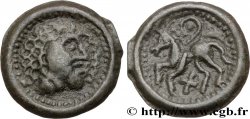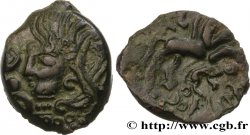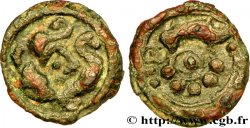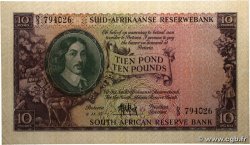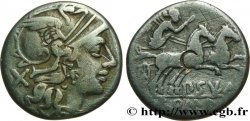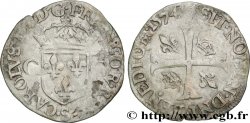v08_0998 - GALLIEN - BELGICA - SUESSIONES (Region die Soissons) Statère d'or CRICIRV
MONNAIES 8 (2000)
Startpreis : 579.31 €
Schätzung : 838.47 €
Erzielter Preis : 625.04 €
Startpreis : 579.31 €
Schätzung : 838.47 €
Erzielter Preis : 625.04 €
Type : Statère d'or CRICIRV
Datum: c. 70-50 AC
Metall : Gold
Durchmesser : 18 mm
Stempelstellung : 10 h.
Gewicht : 5,83 g.
Seltenheitsgrad : R2
Kommentare zum Erhaltungszustand:
Flan légèrement ovale et irrégulier / Faiblesse de frappe sur la légende au revers
N° im Nachschlagewerk :
Vorderseite
Titulatur der Vorderseite ANÉPIGRAPHE.
Beschreibung Vorderseite Buste décomposé montrant l'œil, l'epsilon, une aile et une rosace.
Rückseite
Titulatur der Rückseite [CRICIRV].
Beschreibung Rückseite Cheval galopant à gauche surmonté d'une fibule ; au-dessous, un cercle perlé.
Kommentare
Ce type a donné lieu à plusieurs interprétations et attributions : Médiomatriques, Meldes ou Bellovaques avant de revenir aux Suessions. Ce type semble dériver du statère à l'œil. L'atelier semble avoir été situé sur l'oppidum de Pommiers (Aisne) d'après Simone Scheers. Une cinquantaine d'exemplaires proviennent du trésor d'Ambleny (Aisne) alors que des exemplaires ont été trouvés à Pommiers, Vermand et Grand-Rozoy dans l'Aisne, à Senlis dans l'Oise. La série tri-métallique (or, argent et bronze) semble indiquer que le monnayage débute avant la fin de la guerre des Gaules pour l'or et se continue par les émissions d'argent et de bronze, pendant et après la fin de la guerre. Pour la classe 2, nous avons six exemplaires avec trois coins de droit et quatre de revers.
This type has given rise to several interpretations and attributions: Mediomatrics, Meldi or Bellovaci before returning to the Suessiones. This type seems to derive from the stater with the eye. The workshop seems to have been located on the oppidum of Pommiers (Aisne) according to Simone Scheers. Around fifty examples come from the treasure of Ambleny (Aisne) while examples were found at Pommiers, Vermand and Grand-Rozoy in the Aisne, at Senlis in the Oise. The tri-metallic series (gold, silver and bronze) seems to indicate that the coinage began before the end of the Gallic War for gold and continued with the issues of silver and bronze, during and after the end of the war. For class 2, we have six examples with three obverse dies and four reverse dies
This type has given rise to several interpretations and attributions: Mediomatrics, Meldi or Bellovaci before returning to the Suessiones. This type seems to derive from the stater with the eye. The workshop seems to have been located on the oppidum of Pommiers (Aisne) according to Simone Scheers. Around fifty examples come from the treasure of Ambleny (Aisne) while examples were found at Pommiers, Vermand and Grand-Rozoy in the Aisne, at Senlis in the Oise. The tri-metallic series (gold, silver and bronze) seems to indicate that the coinage began before the end of the Gallic War for gold and continued with the issues of silver and bronze, during and after the end of the war. For class 2, we have six examples with three obverse dies and four reverse dies








 Berichten über einen Fehler
Berichten über einen Fehler Die Seite drucken
Die Seite drucken Teilen meiner Auswahl
Teilen meiner Auswahl Stellen Sie eine Frage
Stellen Sie eine Frage Einlieferung/Verkauf
Einlieferung/Verkauf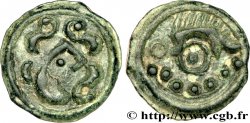
 Details
Details
